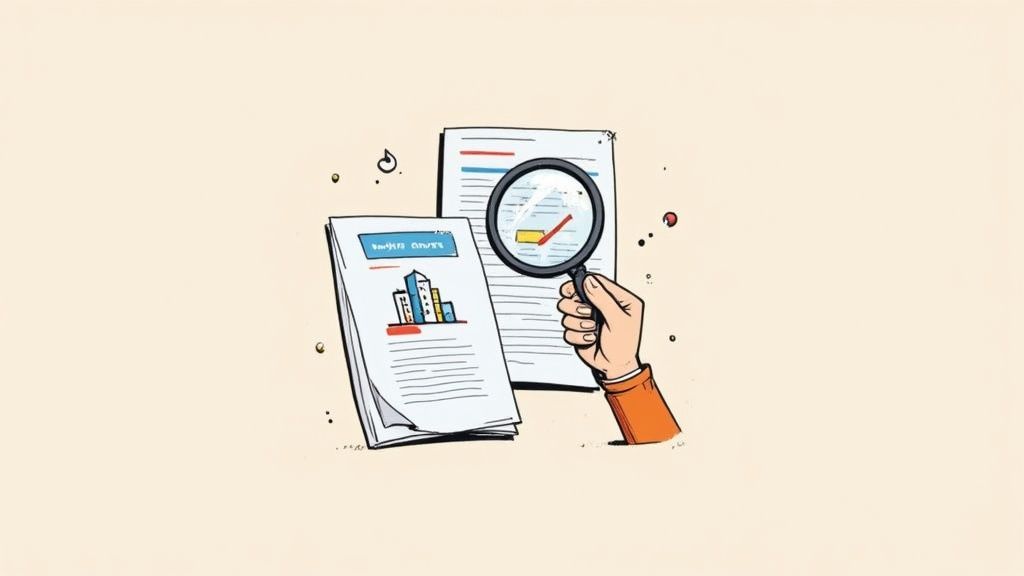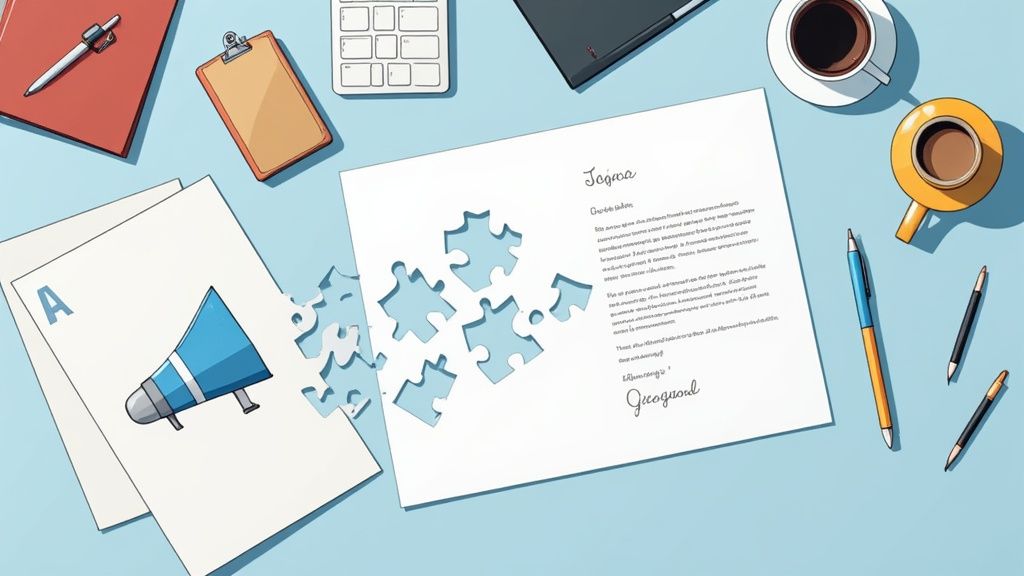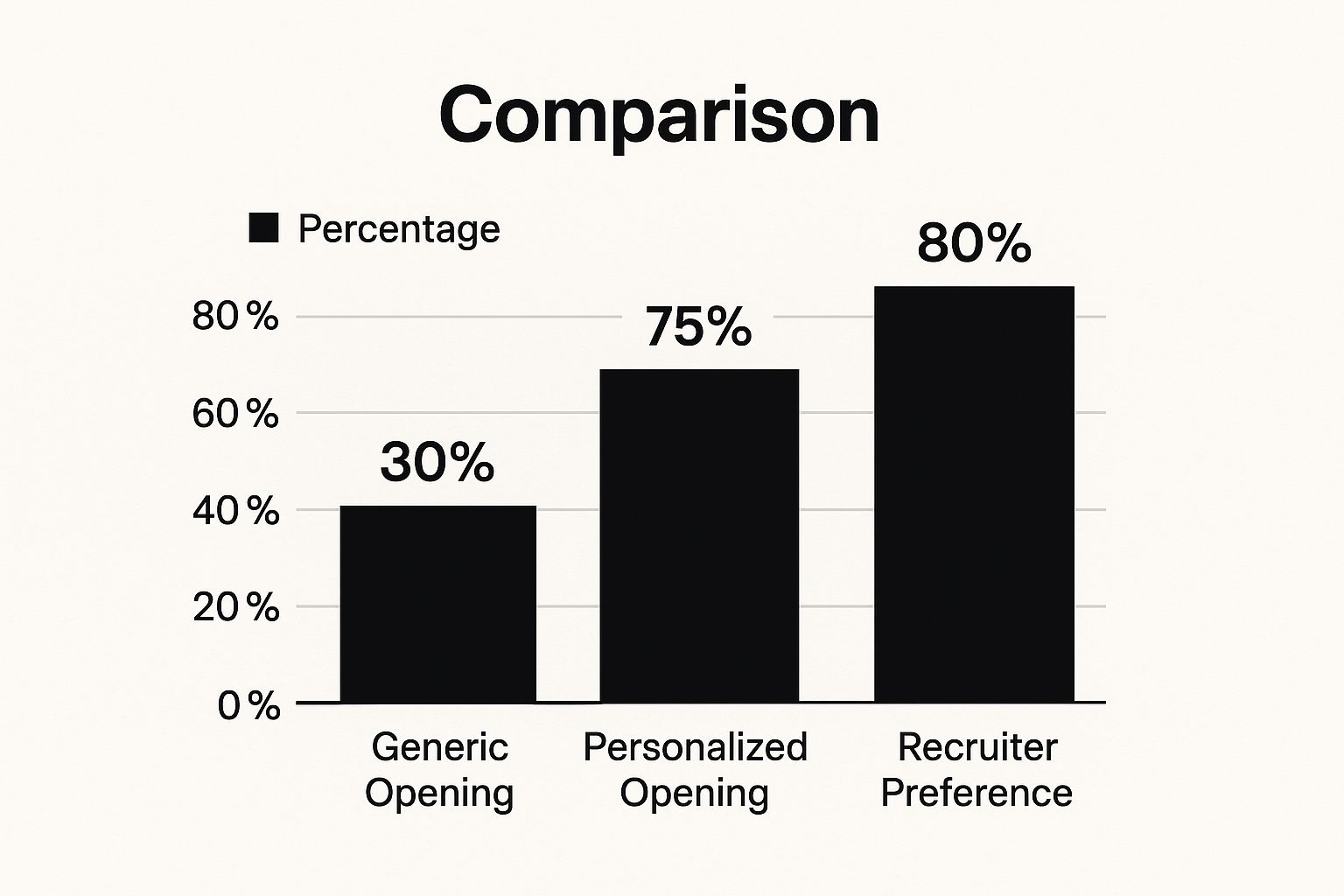
How to Make Your Cover Letter Stand Out & Get Hired Fast
Published
Think of your cover letter as your secret weapon, not just another document to check off a list. The real magic happens when you stop summarizing your resume and start telling a compelling story—one that perfectly aligns your skills with what the company is looking for. This is how you transform a simple application into a conversation starter that hiring managers can't ignore.
Why Your Cover Letter Is Your Secret Weapon

Let's get one thing straight: do people still read cover letters? Absolutely. But here’s the catch—only the good ones get a second glance. A generic, copy-pasted letter is a red flag. It tells the hiring manager you’re not truly invested, and it’s often worse than sending nothing at all.
Your cover letter is your first real shot at having a conversation with a potential employer. It's where you get to show off your personality, your passion, and the way you think, which a list of bullet points on a resume simply can't do. This is especially true in a field as dynamic as influencer marketing, where clear communication and understanding brand voice are paramount.
Your resume lists your qualifications. Your cover letter tells the story of how you'll put those qualifications to work. It’s the bridge between what you've done and the value you'll bring to the company.
Think of it this way: your resume is the "what" and the "where." Your cover letter is the "why" and the "how." It tackles the questions a simple work history can't touch:
- Why are you genuinely excited about this specific influencer marketing role?
- How does your background directly solve a problem this company is likely facing?
- What makes you a better fit—both culturally and strategically—than the other 100 applicants in the pile?
The Data Doesn't Lie
Still think you can skip it? The numbers tell a different story. Taking the time to write a thoughtful cover letter gives you a measurable edge.
The table below breaks down just how much of an impact this "extra step" can have on your job search.
Cover Letter Impact at a Glance
| Statistic | What It Means for You |
|---|---|
| 35.8% of candidates who always submitted a cover letter received job offers. | You're boosting your chances of getting hired by a significant margin just by including one. |
| Only 21.2% of those who never submitted a cover letter got an offer. | Skipping this step puts you at a clear disadvantage against more motivated candidates. |
| Recruiters often use them to break ties between equally qualified candidates. | When resumes look similar, your cover letter is what sets you apart and makes the final call. |
You can explore more on this in the detailed findings from Resume.io.
This advantage is all about effort. Since so many people either skip the cover letter or send a lazy, one-size-fits-all version, you immediately stand out by showing you cared enough to write something specific. You're signaling that you aren't just looking for any job—you’re actively pursuing their job.
Ultimately, your cover letter is your chance to connect the dots for the recruiter. You’re framing your experience in a way that directly addresses their needs, making their decision to interview you that much easier. It's not just an extra task; it's a strategic move that seriously boosts your odds of landing the role.
Conducting Research That Gets You Noticed

Let’s be honest: a generic cover letter is a one-way ticket to the trash folder. If you really want to stand out, you have to do more than just glance at the company's "About Us" page. Proper, targeted research is what separates a decent application from one that gets a hiring manager to stop scrolling and actually pay attention.
This isn't just about proving you did your homework. It’s about gathering intelligence. The specific details you find are the ammunition you'll use to connect your skills directly to what the company is working on right now. You’re showing them you don't just want a job—you want this job, because you're the person who can solve their specific problems.
Don't just take my word for it. The data shows that a massive 94% of hiring managers say cover letters influence their interview decisions. A letter packed with specific insights screams that you’re a serious candidate who invested real effort. If you need more convincing, you can learn more about why cover letters are still essential in today's job market.
Dissect the Job Description
First things first, treat the job description like a treasure map. Read between the lines to find the real problems they’re trying to solve. Don't just skim the bullet points.
- When they say they want "Experience managing a $50k+ monthly ad budget," they’re really looking for someone they can trust with significant financial responsibility to deliver a solid ROI.
- If you see "Skilled in building creator relationships from the ground up," it's a huge hint they might be launching a brand-new influencer program or trying to break into a new niche.
- A line like "Proven ability to analyze campaign data and pivot strategy" suggests they need a data-driven expert because their past efforts might have been a shot in the dark.
Treat the job description as a list of pain points. Your cover letter's job is to present yourself as the cure for each one, using your experience as evidence.
Once you identify these pain points, you can ditch generic claims. Instead of saying, "I have great communication skills," you can say, "My experience managing a $200k influencer marketing budget for Brand X resulted in a 15% jump in engagement, and I'm confident I can deliver similar growth for your team." See the difference?
Go Beyond Their Website
After you’ve thoroughly dissected the job description, it’s time to put on your detective hat and dig deeper. Your mission is to find recent, relevant information that proves you're genuinely tuned in to their world.
A great first step is finding the hiring manager on LinkedIn. A quick search for the Head of Marketing or Influencer Marketing Manager can often give you a name. Addressing your letter to a real person instead of "To Whom It May Concern" is a small detail that makes a huge impact.
Next, look for recent company news. Did they just launch a major product? Close a round of funding? Announce a cool new partnership? Mentioning these events shows you’re not just a random applicant. For example, you could write something like, "I was incredibly impressed by your recent 'CreatorFirst' campaign and immediately saw how my experience in grassroots community building could support similar initiatives." This proves you're already thinking like part of the team.
Choosing a Format That Tells Your Story
Your cover letter’s format is more than just aesthetics—it’s a strategic choice. The structure you pick is the very first thing that signals your professional approach, and the right one can make all the difference in grabbing a hiring manager's attention. Forget those generic, one-size-fits-all templates that just rehash your resume.
Think of your format as the framework for your professional story. For influencer marketing jobs, where showing you understand brand challenges and can deliver ROI is everything, one format consistently outperforms the rest: the Problem-Solution model.
The Power of the Problem-Solution Format
This approach immediately tells a hiring manager you’re not just another applicant; you’re a problem-solver. It’s simple but incredibly effective. You start by identifying a specific challenge or goal you’ve noticed the company has, which you've figured out from your research. Then, you frame your experience and accomplishments as the perfect solution.
Why does this work so well? Because it speaks the language of business. You’re showing that you've already started thinking about their success, not just your own career goals. You're not just saying, "I'm skilled at X." Instead, you're proving, "I see you need to achieve Y, and I have a track record of delivering Z to solve that exact kind of problem."
This personalized approach is exactly what recruiters are looking for.

The data doesn't lie. A cover letter that feels tailored, which is the heart of the Problem-Solution format, dramatically increases your odds of getting a response.
Exploring Other Strategic Formats
While the Problem-Solution approach is a fantastic go-to for most influencer marketing roles, it’s not the only game in town. Depending on your background or the specific role you’re targeting, another narrative style might better showcase your strengths.
Every cover letter tells a story, but not all stories are told the same way. The structure you choose can emphasize different aspects of your professional identity—from raw data to creative flair. Picking the right one helps you control the narrative from the very first sentence.
To help you decide, here’s a quick comparison of the most effective cover letter structures.
Cover Letter Format Comparison
| Format Type | Best For | Core Strategy |
|---|---|---|
| Problem-Solution | Most influencer marketing roles, especially strategy-focused ones. | Identify a company-specific challenge and position your skills as the direct solution. |
| Narrative | Creative or brand-facing roles where storytelling is key. | Weave your professional journey into a compelling story that shows personality and passion. |
| Achievement-Focused | Technical, data-heavy, or performance marketing roles. | Lead with quantifiable results and hard metrics, often using bullet points for impact. |
Let’s dig a little deeper into these alternatives.
The Narrative Format: This is your chance to shine if you’re applying for a creative position. It reads more like an engaging article than a formal letter, allowing you to connect with the brand on a personal level. We've got a great example of this style in our guide on the account manager cover letter.
The Achievement-Focused Format: Perfect for data-driven roles. This format gets straight to the point. It often uses bolded numbers and bullet points right at the top to showcase your most impressive, quantifiable wins.
Your format is more than a layout. It’s a deliberate choice that communicates your professional approach before the hiring manager reads a single full sentence.
Remember, hiring managers are busy. In fact, research shows that 66% of job seekers believe cover letters should be half a page or less. The Problem-Solution format is brilliant for this because it’s concise and gets right to what the employer cares about most, positioning you as an immediate asset.
Ultimately, by harnessing the power of structure in writing, you ensure your cover letter is clear, persuasive, and tells a story that no one else can.
Crafting an Opening That Demands Attention

Let's be honest—hiring managers are drowning in applications. They spend just a few seconds on each one, which means your opening paragraph isn't just an intro; it's your entire first impression. You have one, maybe two sentences to stop them from reflexively clicking "next."
That's why a bland opener like, "I am writing to express my interest..." is the kiss of death. It’s a guaranteed way to get lost in the noise. To really stand out, you need a hook that immediately telegraphs your value, confidence, and genuine excitement for the role.
Lead With a Powerful Achievement
The quickest way to get a hiring manager to lean in is to hit them with a hard, quantifiable result right away. Forget the formalities and lead with a major win that directly mirrors what they're looking for.
Think of it this way:
The Bland Before: "I am writing to apply for the Influencer Marketing Manager position. I have several years of experience and believe my skills would be a great fit for your team."
The High-Impact After: "Last quarter, I grew my client's TikTok engagement by 300% by building a micro-influencer network from the ground up. I'm excited by the opportunity to bring that same strategic growth to the Influencer Marketing Manager role at your company."
See the difference? The second example doesn’t just say you have experience; it proves your impact. It immediately answers the silent question on every recruiter’s mind: “What can you do for us?”
Mention a Connection or Passion Point
Another killer strategy is to create an immediate personal connection. This isn't about being disingenuous; it's about showing you're paying attention. Maybe you know someone at the company, saw a team member speak at a conference, or were truly impressed by a recent campaign.
Mentioning a recent company achievement, like their 'CreatorFirst' campaign, or referencing a mutual connection shows you’ve done your homework. It transforms you from a stranger into an informed and interested candidate.
This approach proves you aren't just spamming out applications. It shows you have a specific, thoughtful reason for wanting to join their team, making your interest feel exclusive and genuine.
Ultimately, a killer opening sets the entire tone for your application. Mastering effective written communication skills is what makes these hooks work. You’re replacing generic fluff with compelling substance, demanding the reader’s attention from the very first word and ensuring your cover letter gets the consideration it deserves.
Turning Your Skills Into Compelling Evidence
So you've hooked them with a great opening. Now comes the hard part: proving you can actually do the job. The body of your cover letter is where you build your case, and simply listing your skills from your resume won't cut it. Anyone can say they're a great collaborator or a skilled campaign manager.
The real secret is to stop telling and start showing. How do you do that? By turning your accomplishments into mini-stories that prove your value.
One of the most effective ways I've found to do this is with the Challenge-Action-Result (CAR) method. This simple framework helps you transform a flat statement into a compelling narrative of your impact. It forces you to connect your actions to real, measurable outcomes—which is exactly what hiring managers are desperate to see.
Using The Challenge-Action-Result Method
Think of the CAR method as your secret weapon for quantifying your value. Instead of just claiming a skill, you’re essentially building a mini case study in a single paragraph. This approach demonstrates your abilities, your thought process, and your business savvy all at once.
Here’s the breakdown:
Challenge: Start with the problem. What was the specific business issue or situation you were up against? This sets the stage and shows you understand the why behind the work.
Action: What did you do? Detail the specific steps you took to tackle the challenge. This is where you highlight your skills, initiative, and strategic thinking.
Result: Finally, what happened? This is the most critical part. Share the measurable, tangible outcome of your actions. Use hard numbers, percentages, and concrete improvements to prove your worth.
Let's look at a real-world example for an influencer marketing role.
A generic cover letter might say: "I am experienced in growing social media engagement." It’s not terrible, but it’s forgettable.
Now, let's use the CAR method:
"When I joined Brand X, our influencer marketing ROI had been flat for two quarters (Challenge). I developed and launched a new strategy centered on long-term partnerships with micro-influencers in our specific niche, moving away from one-off campaigns (Action). Within six months, this approach drove a 45% increase in attributed sales and a 60% boost in organic brand mentions (Result)."
See the difference? The second version is powerful.
The CAR method moves you from a passive applicant to an active problem-solver. It tells the hiring manager, "Here's a problem you likely have, and here's direct evidence that I know how to solve it."
Tailoring Your Evidence to the Role
Of course, your proudest moments won't land with impact if they aren't relevant to the job you're applying for. Always go back to the job description. If they mention needing someone to improve creator retention, share a CAR story about how you did exactly that.
To make your application even stronger, you'll want to weave in the right keywords. Checking out a good marketing resume keywords list can help you find the specific terms and phrases that recruiters and hiring systems are looking for.
Think of your cover letter like a proposal. It’s not just about listing qualifications; it’s about making a persuasive argument. Learning the strategies for writing a winning proposal can actually give you an edge in crafting a more compelling narrative.
When you frame your experience this way, each paragraph becomes a powerful piece of evidence. You’re no longer just listing skills—you're building an undeniable case for why you’re the perfect person for the job.
Answering Your Final Cover Letter Questions
Even after you've poured your heart and soul into crafting a great cover letter, a few tricky questions always seem to pop up right at the end. Things like length, tone, and whether to use that fancy new AI tool can feel like last-minute hurdles.
Let's clear those up so you can hit "send" without a second thought.
Should I Use AI to Help Write My Cover Letter?
This is the big question on everyone's mind right now. My take? AI tools can be a decent starting point if you're battling writer's block. They're great for brainstorming or getting a basic structure down on paper. But—and this is a big one—you should never just copy and paste what an AI spits out.
Trust me, recruiters are getting really good at sniffing out generic, AI-written text. It has a certain soulless quality. The best way to use AI is as your assistant, not your author. Let it build a rough scaffold, then you come in and make it yours. Add your own voice, your specific stories, and your genuine passion. That's the stuff that actually gets you noticed.
Your personality and specific, researched details are your greatest assets. AI can build the frame, but you must hang the pictures. Use it to overcome writer's block, not to replace your authentic voice.
How Long Should My Cover Letter Be?
Keep it short and sweet. Seriously. Hiring managers are juggling a dozen things at once, and a wall of text is an instant turn-off. The sweet spot is 250 to 300 words, which usually comes out to about half a page.
That's just enough room to do what you need to do:
- Grab their attention with a killer opening.
- Highlight one or two of your proudest achievements.
- Show you’re genuinely excited about this specific role.
- End with a confident call to action.
Anything longer risks getting skimmed or, worse, tossed aside. Think three to four short, punchy paragraphs.
Is It Okay to Show Personality?
Absolutely! In a creative field like influencer marketing, showing some personality is often your biggest advantage. It’s what separates you from the dozens of other applicants who sound like they've all used the same boring template. It makes you memorable.
But you have to be smart about it. The trick is to match the company's vibe. Before you start writing, do a little digging.
- How do they talk on their "About Us" page or their social media?
- Is their tone casual and fun, or is it more buttoned-up and corporate?
If you’re applying to a scrappy startup with a hilarious Instagram feed, a bit of wit can go a long way. If it’s a massive global corporation, you’ll probably want to dial it back and keep things more professional.
One last thing—after you've sent your application, your job isn't quite done. Knowing how to write a polite and effective application follow-up email is a pro move that keeps you on the recruiter's radar.
Ready to find the perfect role to send that standout cover letter to? Influencer Marketing Jobs is the premier destination for connecting talented professionals with top opportunities in the industry. Browse our curated listings at https://influencermarketingjobs.net and take the next step in your career today.